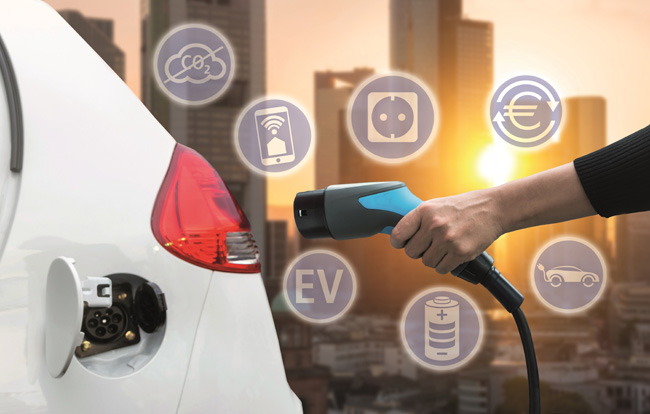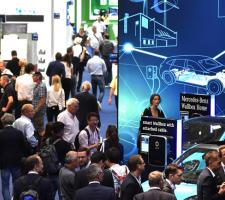
As sales of electric vehicles accelerate, the growth of charging infrastructure is in need of a big boost. Graham Anderson reports on whether Europe is up to it
Utilities, technology companies and vehicle manufacturers are battling to put in place new charging networks for electric vehicles (EVs) across Europe in response to a predicted dramatic surge in demand.
Market experts believe that rapidly falling battery costs – which make up about one third of the costs of an electric car – and growing environmental concerns together mean that the EV market is fast reaching a ‘tipping point’, with growth about to accelerate exponentially.
The issue was central to this summer’s inaugural Power2Drive conference and exhibition in Munich, Germany, launched as part of the well-established Smarter E-Europe event which attracted 1,300 exhibitors – 150 of them in the emerging EV charging sector - and over 50,000 visitors.
In Germany, the official Federal Network Agency says there are currently 100,000 EVs in the country. It expects that there will be one million by 2020 and six million by 2030.
Experts at the Technical University of Munich (TUM) are even more bullish. They say that around eight million EVs could be on the road in Germany alone by 2030.
This rapid shift away from the internal combustion engine is already creating demands for large numbers of new - and faster - charging stations, and a range of services to suit different types of customer.
Ubitricity: Lampposts as charging points
Ubitricity’s technology encompasses three elements: a smart electric meter that is incorporated into the charging cable and handles battery-charging billing, a mobile electricity contract that is linked to the charging cable, and power sockets that can be installed anywhere — essentially creating docking stations to the grid.
Known as SimpleSockets, these outlets can be inexpensively installed in parking garages, residential and commercial buildings, and existing infrastructure systems such as street lamps. In a pilot project, SimpleSockets were installed in dozens of street lamps in several London boroughs. Drivers merely need to park next to such street lamps and use the mobile “tap” to purchase electricity that is then directly billed.
The company says it takes about half an hour and around €1,000 to convert a street lamp — a fraction of what it costs in time and money to install a separate charging station.
After a smart cable is inserted into the socket, it identifies the charging point and turns on the power. Once the charging process has been completed, the associated data is transmitted to Ubitricity via a secure mobile communications link. The company then forwards the data to mobile power suppliers, who bill the users each month for the electricity they have consumed.
There is one notable downside, however. The lampposts need to be close to the kerb, or the cable creates a trip hazard.
Energy fears
The debate is dominating the strategies of firms right across the energy and automotive supply chains - from utilities and petrol stations to auto manufacturers and technology start-ups – as they work out how to respond.
There are also fears in the energy industry that such a massive switch to EVs could destabilise national grids without careful management or substantial investment.
To meet demand, TUM says there will need to be around 4.7 million charging stations in Germany by 2030, including 200,000 high-speed charging stations, a massive increase. In September 2017, the latest available official figures, only 4,730 public charging stations were in operation in the country.
Similar rates of change are being predicted right around the world – with EVs increasingly dominating not just private cars but also commercial vehicles, public transport and even water transport. For example, there are already an estimated 200 million electric bikes in China and that number is growing fast.
In his opening keynote in Munich, Michael Liebreich, founder of Bloomberg New Energy Finance, UK, said the changes will be little short of revolutionary.
With much of the energy for the EV market increasingly provided by renewables, Bloomberg believes that the oil market will suffer, government revenues from petrol and diesel sales will reduce sharply, car manufacturers will have to rethink their business models and the entire automotive supply chain will face a major upheaval, with manufacturers of many parts – such as gearboxes – being hard hit.
Urgent rethink
On top of that, the oil companies are urgently rethinking their downstream business models and the role that their existing networks of petrol stations will play in this new environment.
Christopher Burghardt, Europe managing director of US firm
Based in San José, US, ChargePoint is backed by
Key EV points
• Range of charging systems being developed to meet different needs
• Politicians are implementing policies to curb emissions
• Consumer demand for EVs is at record levels
• Car manufacturers are investing billions in e-mobility
• Climate concerns are driving innovation
Existing AC charging points have been criticised as too slow, but Burghardt does not think that will be a problem. He told the Power2Drive conference: “Change is happening now. Every week, countries, regions and cities make new commitments to electrification. We will see a combination of AC charging and DC fast-charging networks. I think people are underestimating the potential and market acceptance of AC charging. It gives most people what they need – top-up charging – and you will top up on a regular basis. DC will be reserved for long-distance charging.”
He added that, in his view, curbing pressure on the grid is going to be a lot more simple than people think “through flexible charging, customisable charging options, access control and power management software”.
He also argued that the current, highly fragmented market will begin to consolidate very soon. “There should only be two or three charging networks in Europe – after all, you only want two or three apps on your phone.”
But Stefan Van Dobschütz, CCO eMobility with German energy company Innogy – it has 17,000 charging points in more than 20 countries – warned that the electricity distribution network could become a major bottleneck without careful planning.
“Grids are dimensioned for peak load so either we need to plan for a significant and expensive expansion of the grids or look at control of the distribution network via flexibility and smart charging – that is to say preventing load peaks through charging controls,” he said.
This might mean that charging at peak times will be limited or much more expensive.
Solutions menu
Ralf Martin Müller of wind turbine manufacturer Enercon – a company that is increasingly interested in the storage and charging markets – agreed that the market is going to need a ‘menu’ of charging solutions, both to respond to different user needs and to manage loads on the national grids.
A delivery firm with a fleet of vans driving long distances every day is going to need a different charging network from a domestic user using their car for the school run and a short commute. As for domestic drivers: “If you do not own a garage or can’t park on your own land – which is the majority of drivers – how are you going to charge your car?” Müller asks. Enercon believes part of the solution will be a network of charging stations – like petrol stations today - enhanced with buffer batteries fed by renewable sources to minimise the impact on the grid and ensure a steady supply.
Using its expertise from the renewable energy sector, the wind turbine manufacturer has also launched a new 350kW quick-charging station offering a range of 250 miles with an eight-minute charge.
Müller said: ‘We will need a variety of solutions – for example, buffer batteries, grid reinforcement and management, and behavioural change.”
At the other end of the scale, German manufacturer Ubitricity is converting lampposts in some cities into charging points for EVs.
Economical solution
Knut Hechtfischer, co-founder of Ubitricity, told ITS International: “We are focusing on single phase AC charging which works perfectly for residents overnight - quick charging on the other hand would not work on lampposts. This is the most economical solution because it works with existing infrastructure, and it is very simple to build where a council wants it.”
He added: “Our mobile charging system makes charge points more affordable where EV users typically park, both during the daytime and overnight. Most people are not travelling long distances on a regular basis - if they are, they will have to access a complementary fast-charging service. Our approach will be part of an evolving infrastructure mix reflecting the overall spectrum of user needs.”
There are a myriad of other options under discussion: battery-swapping stations – where you drive in and swap your battery for a fully-charged one – have been touted as another solution.
Wireless or inductive charging systems are also grabbing headlines. The utility firm E.ON is developing its own wireless charging system and car manufacturers
The EV charging market is new, expanding and fragmented, with a large number of players of all sorts all jostling for position and seeking market acceptance.
But as of today, only one thing is clear. Change is coming – and fast. And few parts of the global economy will remain unaffected.
Porsche’s 800-volt pilot project
Porsche’s first two pilot 800-volt EV charging stations - situated at the Berlin-Adlershof Technology Park (pictured) - were connected to the grid in July.
The company explains: “At the moment, DC fast-charging stations for electric cars normally operate at a voltage level of around 400 volts. Depending on the charging power in kW, the charging time for a range of 400km is currently between 40 and 80 minutes. Increasing the voltage level to 800 volts significantly reduces the charging time to less than 20 minutes for the same range.”
The spaces at Berlin-Adlershof are available for fast-charging vehicles equipped with a combined charging system connector. The Porsche Taycan will be the auto manufacturer’s first production vehicle to feature the 800-volt technology, and is due to arrive on the market in 2019.
Porsche says construction of the 800-volt charging infrastructure at the Berlin-Adlershof site was implemented as a pilot project for testing the innovative technology and gathering experience with a view to integrating a fast-charging park at other Porsche Centres.
Explaining its strategy, the manufacturer added: “For longer trips where making good time is of the essence, long waiting times for charging can make a big difference and are generally not acceptable to users. To keep the process brief, high charging power is required.”












